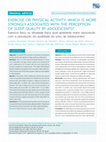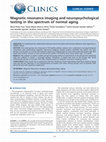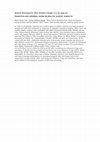Papers by Paula Rejane Beserra Diniz

Revista Paulista de Pediatria
RESUMO Objetivo: Analisar a associação do exercício físico e da atividade física com a percepção ... more RESUMO Objetivo: Analisar a associação do exercício físico e da atividade física com a percepção da qualidade do sono em adolescentes. Métodos: Trata-se de um estudo com abordagem quantitativa que integra o levantamento epidemiológico transversal de base escolar e abrangência estadual cuja amostra foi constituída por 6.261 adolescentes (14 a 19 anos), selecionados por meio de uma estratégia de amostragem aleatória de conglomerados. Os dados foram coletados a partir do questionário Global School-based Student Health Survey. O teste do qui-quadrado e a regressão logística binária foram utilizados nas análises dos dados. Resultados: Na amostra, 29% dos adolescentes não faziam exercício e não foram classificados como fisicamente ativos. Os adolescentes que não praticavam exercício físico tinham mais chances de apresentar uma percepção negativa da qualidade do sono (OR 1,13, IC95% 1,04-1,28; p=0,043). Não foi encontrada associação entre o nível de atividade física e a percepção da qualid...

Clinics (São Paulo, Brazil), 2013
To understand the relationships between brain structures and function (behavior and cognition) in... more To understand the relationships between brain structures and function (behavior and cognition) in healthy aging. The study group was composed of 56 healthy elderly subjects who underwent neuropsychological assessment and quantitative magnetic resonance imaging. Cluster analysis classified the cohort into two groups, one (cluster 1) in which the magnetic resonance imaging metrics were more preserved (mean age: 66.4 years) and another (cluster 2) with less preserved markers of healthy brain tissue (mean age: 75.4 years). The subjects in cluster 2 (older group) had worse indices of interference in the Stroop test compared with the subjects in cluster 1 (younger group). Therefore, a simple test such as the Stroop test could differentiate groups of younger and older subjects based on magnetic resonance imaging metrics. These results are in agreement with the inhibitory control hypotheses regarding cognitive aging and may also be important in the interpretation of studies with other clini...
Jornal Brasileiro de Psiquiatria, 2014

ABSTRACT The loss of brain volume or atrophy is an important index of tissue destruction and it c... more ABSTRACT The loss of brain volume or atrophy is an important index of tissue destruction and it can be used to diagnosis and to quantify the progression of neurodegenerative diseases, such as multiple sclerosis. In this disease, the regional tissue loss occurs which reflects in the whole brain volume. Similarly, the presence and the progression of the atrophy can be used as an index of the disease progression. The objective of this work was to determine a statistical segmentation parameter for each single class of brain tissue using generalized Tsallis entropy. However, the computer algorithm used should be accurate and robust enough to detect small differences and allow reproducible measurements in following evaluations. In this work we tested a new method for tissue segmentation based on pixel intensity threshold. We compared the performance of this method using different q parameter range. We could find a different optimal q parameter for white matter, gray matter, and cerebrospinal fluid. The results support the conclusion that the differences in structural correlations and scale invariant similarities present in each single tissue class can be accessed by the generalized Tsallis entropy, obtaining the intensity limits for these tissue class separations. Were used for analysis of magnetic resonance imaging examinations of 43 patients and 10 healthy controls matched on the sex and age for validation of the algorithm. The values found for the entropic index q were: for the cerebrospinal fluid 0.2; for the white matter 0.1 and for gray matter 1.5. The results of the extraction of the tissue not brain can be seen, visually, a good target, which was confirmed by the values of total intracranial volume. These figures showed itself with variations insignificant (p >= 0.05) over time. For classification of the tissues find errors of false negatives and false positives, respectively, for cerebrospinal fluid of 15% and 11% for white matter 8% and 14%, and gray matter of 8% and 12%. With the use of this algorithm could detect an annual loss for the patients of 0.98% which is in line with the literature. Thus, we can conclude that the entropy of Tsallis adds advantages to the process of target classes of tissue, which had not been demonstrated previously. A perda volumétrica cerebral ou atrofia é um importante índice de destruição tecidual e pode ser usada para apoio ao diagnóstico e para quantificar a progressão de diversas doenças com componente degenerativo, como a esclerose múltipla (EM), por exemplo. Nesta doença ocorre perda tecidual regional, com reflexo no volume cerebral total. Assim, a presença e a progressão da atrofia podem ser usadas como um indexador da progressão da doença. A quantificação do volume cerebral é um procedimento relativamente simples, porém, quando feito manualmente é extremamente trabalhoso, consome grande tempo de trabalho e está sujeito a uma variação muito grande inter e intra-observador. Portanto, para a solução destes problemas há necessidade de um processo automatizado de segmentação do volume encefálico. Porém, o algoritmo computacional a ser utilizado deve ser preciso o suficiente para detectar pequenas diferenças e robusto para permitir medidas reprodutíveis a serem utilizadas em acompanhamentos evolutivos. Neste trabalho foi desenvolvido um algoritmo computacional baseado em Imagens de Ressonância Magnética para medir atrofia cerebral em controles saudáveis e em pacientes com EM, sendo que para a classificação dos tecidos foi utilizada a teoria da entropia generalizada de Tsallis. Foram utilizadas para análise exames de ressonância magnética de 43 pacientes e 10 controles saudáveis pareados quanto ao sexo e idade para validação do algoritmo. Os valores encontrados para o índice entrópico q foram: para o líquido cerebrorraquidiano 0,2; para a substância branca 0,1 e para a substância cinzenta 1,5. Nos resultados da extração do tecido não cerebral, foi possível constatar, visualmente, uma boa segmentação, fato este que foi confirmado através dos valores de volume intracraniano total. Estes valores mostraram-se com variações insignificantes (p>=0,05) ao longo do tempo. Para a classificação dos tecidos encontramos erros de falsos negativos e de falsos positivos, respectivamente, para o líquido cerebrorraquidiano de 15% e 11%, para a substância branca 8% e 14%, e substância cinzenta de 8% e 12%. Com a utilização deste algoritmo foi possível detectar um perda anual para os pacientes de 0,98% o que está de acordo com a literatura. Desta forma, podemos concluir que a entropia de Tsallis acrescenta vantagens ao processo de segmentação de classes de tecido, o que não havia sido demonstrado anteriormente.

In order to investigate cognitive and cerebral aging in healthy elderies neuropsychological asses... more In order to investigate cognitive and cerebral aging in healthy elderies neuropsychological assessment (NP) was compared to measures of magnetic resonance imaging (MRI). Then, 60 healthy elderly subjects were evaluated with Mattis Dementia Rating Scale (MDRS), Stroop Test, Verbal Fluency, Wisconsin Card Sorting Test (WCST), Rey Complex Figure, Vocabulary (Wais III), Logical Memory (WMS R), Visual Reproduction (WMS R), and Rey Auditory-Verbal Learning Test (RAVLT). MRI evaluated volumetric (Gray Matter %, White Matter % and Brain Parenchyma Fraction %), magnetization transfer (MTGM and WM) and relaxometry at T2 (relaxo GM and WM). Statistical analyses were multivariate cluster analysis and Ancova of SAS software version 9.1. Neuropsychological evaluation determined 4 clusters of individuals who had above-average (C1), average (C3 and C4) and below average (C2) performance. Gray Matter Relaxometry differentiated these clusters with C2=183>C4=173>C1=158>C3=156 (p=0.03) after c...
Medical Imaging 2011: Biomedical Applications in Molecular, Structural, and Functional Imaging, 2011
In This study, we used Fractional anisotropy (FA), mean diffusivity (D), parallel diffusivity (D/... more In This study, we used Fractional anisotropy (FA), mean diffusivity (D), parallel diffusivity (D//) and perpendicular diffusivity (D), to localize the regions where occur axonal lesion and demyelization. TBSS was applied to analyze the FA data. After, the regions with alteration were studied with D, D// and D maps. Patients exhibited widespread degradation of FA. With D, D// and D
Epilepsy & Behavior, 2014
Epilepsy & Behavior, 2014
Medicina (Ribeirao Preto. Online), 2008

Journal of the Neurological Sciences, 2010
Kallmann syndrome (KS), characterized by the association of hypogonadotropic hypogonadism and ano... more Kallmann syndrome (KS), characterized by the association of hypogonadotropic hypogonadism and anosmia, may present many other phenotypic abnormalities, including neurologic features as involuntary movements, called mirror movements (MM). MM etiology probably involves a complex mechanism comprising corticospinal tract abnormal development associated with deficient contralateral motor cortex inhibitory system. In this study, in order to address previous hypotheses concerning MM etiology, we identified and quantified white matter (WM) alterations in 21 KS patients, comparing subjects with and without MM and 16 control subjects, using magnetization transfer ratio (MTR) and T2 relaxometry (R2). Magnetization transfer and T2 double-echo images were acquired in a 1.5 T system. MTR and R2 were calculated pixel by pixel to initially create individual maps, and then, group average maps, co-registered with MNI305 stereotaxic coordinate system. After analysis of selected regions of interest, we demonstrated areas with higher T2 relaxation time and lower MTR values in KS patients, with and without MM, differently involving corticospinal tract projection, frontal lobes and corpus callosum. Higher MTR was observed only in pyramidal decussation when compared in both groups of patients with controls. In conclusion, we demonstrated that patients with KS have altered WM areas, presenting in a different manner in patients with and without MM. These data suggest axonal loss or disorganization involving abnormal pyramidal tracts and other associative/connective areas, relating to the presence or absence of MM. We also found a different pattern of alteration in pyramidal decussation, which can represent the primary area of neuronal disarrangement.
Brazilian Journal of Medical and Biological Research, 2010
The brain volume measurements have important clinical applications in the treatment of neurodegen... more The brain volume measurements have important clinical applications in the treatment of neurodegenerative illnesses. The segmentation and the volume calculation are important in the medical context to provide information to assist the physician in disease diagnostic and prognostic. Furthermore, it can improve the speed of the diagnostic. The objective of this article is to describe the development and evaluation of a tool for calculation of the brain volume using Tsallis Entropy.

Arthritis & Rheumatism, 2004
To evaluate the change in osteoarthritic (OA) knee cartilage volume over a two-year period with t... more To evaluate the change in osteoarthritic (OA) knee cartilage volume over a two-year period with the use of magnetic resonance imaging (MRI) and to correlate the MRI changes with radiologic changes. Thirty-two patients with symptomatic knee OA underwent MRI of the knee at baseline and at 6, 12, 18, and 24 months. Loss of cartilage volumes were computed and contrasted with changes in clinical variables for OA and with standardized semiflexed knee radiographs at baseline at 1 and 2 years. Progression of cartilage loss at all followup points was statistically significant (P < 0.0001), with a mean +/- SD of 3.8 +/- 5.1% for global cartilage loss and 4.3 +/- 6.5% for medial compartment cartilage loss at 6 months, 3.6 +/- 5.1% and 4.2 +/- 7.5% at 12 months, and 6.1 +/- 7.2% and 7.6 +/- 8.6% at 24 months. Discriminant function analysis identified 2 groups of patients, those who progressed slowly (<2% of global cartilage loss; n = 21) and those who progressed rapidly (>15% of global cartilage loss; n = 11) over the 2 years of study. At baseline, there was a greater proportion of women (P = 0.001), a lower range of motion (P = 0.01), a greater circumference and higher level of pain (P = 0.05) and stiffness in the study knee, and a higher body mass index in the fast progressor group compared with the slow progressor group. No statistical correlation between loss of cartilage volume and radiographic changes was seen. Quantitative MRI can measure the progression of knee OA precisely and can help to identify patients with rapidly progressing disease. These findings indicate that MRI could be helpful in assessing the effects of treatment with structure-modifying agents in OA.
Studies in health technology and informatics, 2013
With the consolidation of PACS and RIS systems, the development of algorithms for tissue segmenta... more With the consolidation of PACS and RIS systems, the development of algorithms for tissue segmentation and diseases detection have intensely evolved in recent years. These algorithms have advanced to improve its accuracy and specificity, however, there is still some way until these algorithms achieved satisfactory error rates and reduced processing time to be used in daily diagnosis. The objective of this study is to propose a algorithm for lung segmentation in x-ray computed tomography images using features extraction, as Centroid and orientation measures, to improve the basic threshold segmentation. As result we found a accuracy of 85.5%.

Studies in health technology and informatics, 2013
Recently has grown the development of Computer-aided Detection Systems - CAD to improve the diagn... more Recently has grown the development of Computer-aided Detection Systems - CAD to improve the diagnosis of diseases identifying it at the initials stages using medical images. In this work is made a analysis of the performance of an algorithm for lung region extraction in computed tomography exams - CT. The implementation was made in MATLAB and applied to 9 CT scans of patients with lung disease (corresponding to a set of 479 images). The detection of image lung boundaries were classified by an expert radiologist as "Good" and "Poor" according the presence of errors. The results showed deficiencies which damage the algorithm performance, only 52% of the images were rated as "Good" . The problems identified were listed, and when resolved will give the needed quality to the process to be used by radiologist doctors in the patient care.
2011 24th International Symposium on Computer-Based Medical Systems (CBMS), 2011
... Paula RB Diniz, Antonio C. dos Santos Medical School of Ribeirao Preto, FMRP, University of ... more ... Paula RB Diniz, Antonio C. dos Santos Medical School of Ribeirao Preto, FMRP, University of Sao Paulo Bandeirantes Av. ... [10] J. Morra, Z. Tu, L. Apostolova, A. Green, C. Avedissian, S. Madsen, N. Parikshak, XH, A. Toga, C. Jack, N. Schufj, M. Weiner, and P. Thompson. ...

Uploads
Papers by Paula Rejane Beserra Diniz